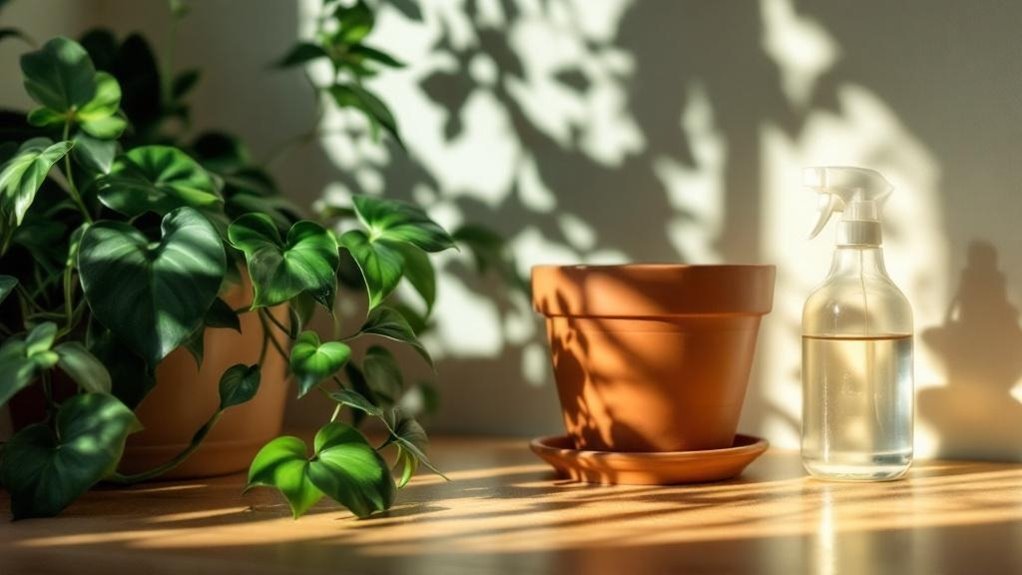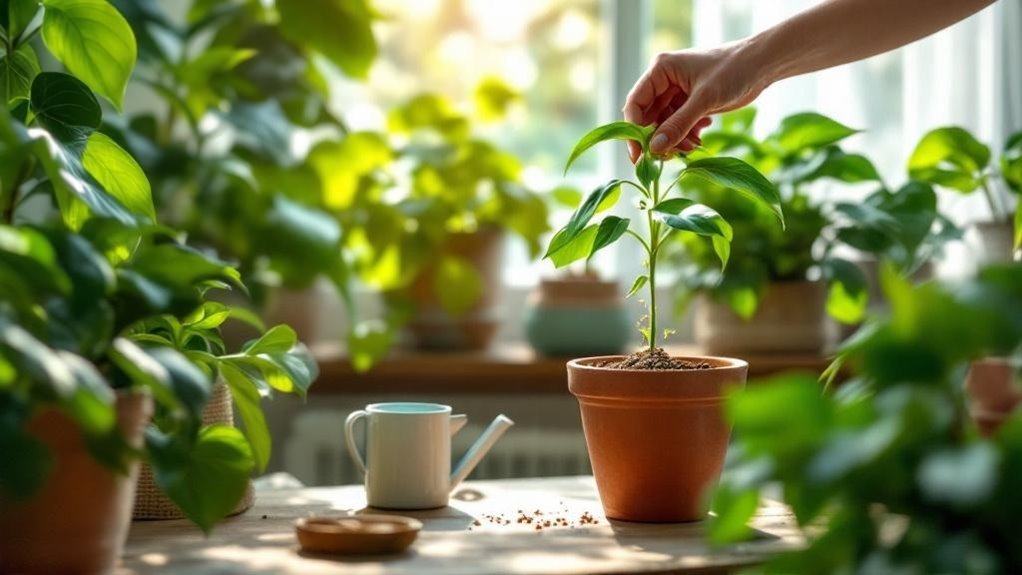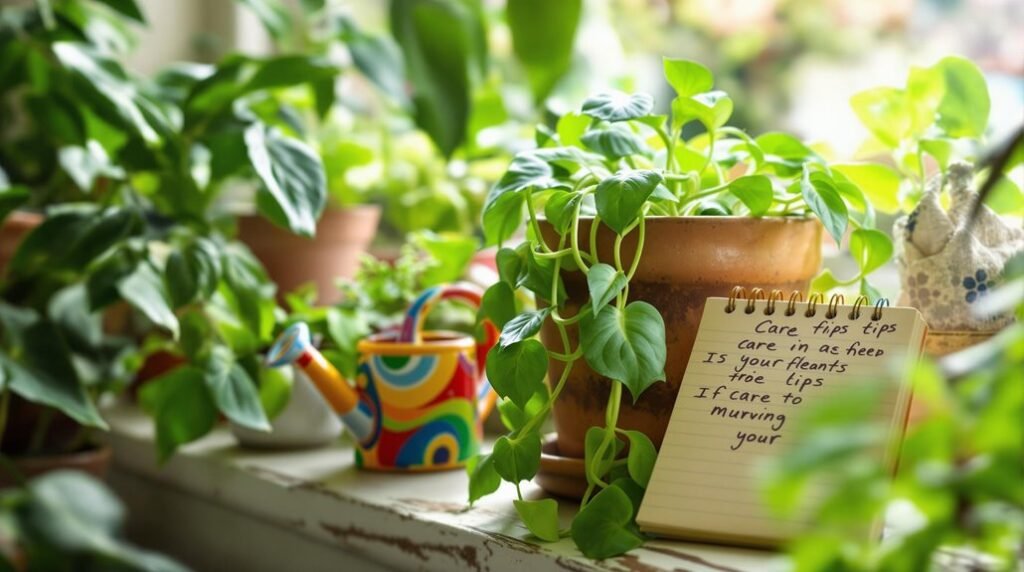Getting started with houseplants can be a gentle introduction to indoor gardening rather than an intimidating task. You’ll want to pick plants that fit your lifestyle and space, but there’s more to it than just choosing a pretty pot. Understanding how light, water, and soil interact is key to keeping your greenery healthy. If you’re ready to avoid common pitfalls and help your plants thrive, it’s worth exploring the basics carefully.
Choosing the Right Houseplants for Beginners
When you’re new to houseplants, choosing low-maintenance varieties like snake plants and pothos can set you up for success.
These resilient plants adapt well to indoor environments and require minimal houseplant care, making them perfect for beginners. You should also consider rubber plants and aloe vera; they’re not only easy to care for but also improve your indoor air quality.
To simplify your routine, pick plants with similar watering needs, so you won’t risk overwatering or underwatering.
Make sure to research each plant’s growth patterns and seasonal requirements to help them thrive.
Understanding Light Requirements for Indoor Plants
Selecting the right houseplants is just the start; understanding their light needs helps you place them where they’ll thrive.
Choosing houseplants is only the beginning; knowing their light needs ensures they flourish in your home.
Light requirements vary widely among indoor plants, so knowing your plant’s preferences guarantees healthy growth. Here’s how to match light conditions to your plants:
- High light plants need full sun, ideally at unshaded windows with 6+ hours of direct sunlight daily.
- Medium light plants prefer bright, indirect light, perfect a few feet away from windows.
- Low light plants tolerate shade but still require some natural light, suitable for offices or rooms with minimal sunlight.
- Use grow lights to supplement light for plants situated in darker spots lacking sufficient natural light.
Effective Watering Techniques to Prevent Overwatering

Even if you’re enthusiastic to see your houseplants flourish, watering them too often can cause more harm than good. Most houseplants need the top inch of soil to dry out between waterings to avoid root rot.
Use pots with drainage holes so excess water doesn’t accumulate at the bottom. You can try bottom watering by placing pots in a bowl of water for about 15 minutes, letting the soil soak moisture from below.
Adjust your watering frequency based on the plant type and environment—for example, succulents need water every two weeks, while snake plants require water every two to four weeks.
Watch for signs like yellowing leaves, which indicate overwatering, and crispy brown tips, signaling underwatering, to fine-tune your watering technique effectively.
Selecting the Best Soil and Pot for Your Plants
How do you choose the right soil and pot to keep your houseplants thriving?
Start by visiting your local nursery to find a high-quality potting mix with peat moss, perlite, and vermiculite for proper drainage and aeration.
Then, pick pots with drainage holes to avoid waterlogging. Here’s a quick guide:
- Use a potting mix suited to your plant type; for succulents, select a soil dry blend that dries quickly.
- Choose pots 1-2 inches larger in diameter than the current container to allow root growth.
- Confirm pots have drainage holes to prevent root rot.
- Refresh soil every 1-2 years by repotting to maintain nutrient quality and moisture control.
Additionally, consider using a mix enhanced with Myco-Tone fungi to promote root development and nutrient absorption.
Following these steps helps your plants stay healthy and happy.
How to Fertilize Your Houseplants Properly

Although your houseplants get some nutrients from their soil, they need regular fertilizing to stay healthy and grow well.
Use a balanced liquid fertilizer with equal parts nitrogen, phosphorus, and potassium—like a 10-10-10 formula—to support growth. Fertilize every 4-6 weeks during spring and summer, reducing or stopping in fall and winter when growth slows.
Always water your houseplants thoroughly before applying fertilizer to prevent root damage and guarantee even nutrient absorption. Dilute the fertilizer to half the recommended strength, especially for sensitive or newly repotted plants, to avoid nutrient burn.
Keep an eye on your plants for yellowing leaves or stunted growth, which signal nutrient deficiencies. Adjust your feeding routine accordingly to keep your houseplants thriving and vibrant.
Pruning and Supporting Your Indoor Plants
When you prune your indoor plants just above a leaf node, you encourage new growth and help maintain their shape. Not all plants need pruning, so first check your plant’s needs to see if and when it’s necessary.
Typically, the best time to prune is in spring, after flowering. Use clean, sharp tools to avoid damaging your plant. High carbon steel shears are a great option for making precise cuts.
Here’s how to effectively prune and support your plants:
- Identify if your plant requires pruning based on its species.
- Prune at the start of the growing season for ideal growth.
- Make precise cuts above leaf nodes using sterilized tools.
- Support weak stems with gentle ties like VELCRO® Brand Garden Ties to avoid harm.
Following these steps keeps your plants healthy and thriving.
Recognizing and Addressing Common Plant Problems
Why do some houseplants struggle despite your best efforts? Often, it’s because their needs aren’t fully met.
Overwatering is a common culprit, causing yellow leaves and root rot—let the soil dry slightly between waterings.
Underwatering shows as crispy brown leaves and soil pulling away from the pot, signaling it’s time to water.
Light also plays a big role; too little light leads to leggy growth and yellow leaves.
Check plants regularly for pests like spider mites or aphids, which can damage leaves; treat infestations promptly with insecticidal soap or neem oil.
Leaf discoloration might indicate nutrient issues or environmental stress, so adjust feeding and conditions as needed.
Tips for Creating a Healthy Indoor Plant Environment
Creating a healthy indoor plant environment starts with understanding each plant’s unique light requirements. To take care of your plants effectively, you need to meet their specific needs.
Successful indoor gardening begins with knowing and meeting each plant’s unique light needs.
Here are four crucial tips:
- Position plants according to their light needs—high light near unshaded windows, medium light in bright indirect areas, and low light in shaded spots with some natural light.
- Water consistently but allow the soil to dry slightly between waterings to avoid root rot caused by overwatering.
- Use pots with drainage holes and well-draining soil to prevent waterlogging and support healthy roots.
- Monitor temperature and humidity regularly, and clean leaves to improve photosynthesis, helping your plant thrive.
Following these steps guarantees you take care of your plant’s needs and create a thriving indoor environment.
Using Tools and Resources to Enhance Plant Care
Although caring for houseplants can sometimes feel challenging, using the right tools and resources makes it much easier to keep them healthy and thriving. Online communities and forums let you ask questions and learn from experienced plant lovers. Printable care guides help you follow specific watering and light needs. Video tutorials on YouTube provide step-by-step visuals for tasks like repotting. Local nurseries offer personalized advice tailored to your plants and environment. Crucial tools like moisture meters and watering cans help you avoid overwatering by accurately checking soil moisture. Additionally, using a 3-in-1 soil meter can enhance your plant care routine by measuring pH levels and sunlight intensity.
| Tool/Resource | Purpose | Benefit |
|---|---|---|
| Moisture Meter | Measures soil moisture | Prevents overwatering |
| Printable Guides | Care instructions | Consistent plant care |
| Online Forums | Community support | Gain expert tips |
| Video Tutorials | Visual learning | Understand techniques easily |
| Local Nurseries | Personalized advice | Tailored care for your plants |
Building a Routine for Consistent Plant Maintenance
When you build a routine for plant maintenance, you make it easier to keep your houseplants healthy and vibrant.
Consistency in plant care is key to thriving plants in your plant collection. Here’s how to create a straightforward routine:
- Check soil moisture weekly and water only when the top inch feels dry.
- Rotate plants every few weeks to encourage even growth and prevent leaning.
- Fertilize monthly during the growing season with a balanced houseplant fertilizer.
- Inspect for pests and diseases every couple of months to catch problems early.
Track your watering, feeding, and growth patterns in a journal or app.
This helps you tailor plant care to each plant’s needs and keeps your plant collection flourishing.
Frequently Asked Questions
How to Take Care of Houseplants for Beginners?
You’ll want to water only when the top inch of soil is dry and use pots with good drainage. Choose easy plants like snake plants, watch for distress signs, fertilize monthly, and keep leaves clean for healthy growth.
Why Is Gen Z Obsessed With Plants?
Plants are your green therapy, calming your mind and easing stress. You’re obsessed because nurturing them feels rewarding, connects you to nature, and matches your eco-friendly values—all while thriving thanks to vibrant social media inspiration.
What Is the Best Houseplant for a Beginner?
You’ll find the Snake Plant perfect because it’s nearly indestructible, thriving with little light and water. It’s low-maintenance, making it ideal if you want a resilient, easy-care houseplant that still looks great indoors.
What Is the Hardest Houseplant to Take Care Of?
Caring for a Fiddle Leaf Fig is like juggling fragile glass balls—you’ll need bright, indirect light and steady humidity. Its precise needs make it one of the toughest houseplants to keep happy and thriving indoors.
Final Thoughts
Did you know that over 60% of new plant owners give up within the first year? Don’t let that be you! By choosing easy-care plants like snake plants or pothos and following simple watering and light tips, you’ll build confidence and enjoy thriving greenery. Remember, a little consistent care goes a long way. Stick with your routine, watch your plants grow, and turn your space into a healthy, vibrant oasis. You’ve got this!
